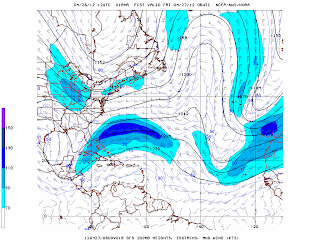Resulta interesante la presencia de
una vaguada en 200 hPa la cual se sitúa sobre el Golfo de México, la misma se
extiende desde el sector NE de Dicho golfo hacia el SW y hasta aproximarse al
Golfo de Campeche; este sistema provoca un ambiente difluente mayormente sobre
la mitad oriental de Cuba, Las Bahamas y Haití, lo cual se conjuga con una capa
de humedad alrededor del 90 % sobre la mitad oriental de Cuba. Este patrón está
causando nublados en capas con predominio de nublados altos con actividad de
chubascos y lluvias en la mitad oriental de Cuba y La Española, situación que
se mantendrá durante el día de mañana. Al mismo tiempo para mañana la tendencia
de esta vaguada en la altura será de profundizar y moverse lentamente hacia el
E-NE, ahora bien, el día 28 la vaguada en la altura se hallará en el extremo
oriental del Golfo de México y comenzará a amortiguarse y abrirse, pero la
persistencia de esta vaguada en el área hará que profundice en el resto de los
niveles inferiores y se refleje en 700, 850 hPa además de superficie como una
hondonada invertida que se extenderá desde Las Bahamas, cruzará la región
central de Cuba hasta el Mar Caribe; de igual forma la capa de humedad en 700
hPa se extenderá hacia Las Bahamas y porción sur de La Florida. Independientemente
que el sector activo de la hondonada en superficie se halle sobre Las Bahamas y
región central de Cuba el flujo del NE que antecede a la hondonada trasladará
desde el día 28 nublados con actividad de chubascos y lluvias, donde el día 29
se incrementa la probabilidad de lluvias en sur de la Florida con el movimiento
del sistema. El día 30 la hondonada en superficie ira trasladándose hacia el
oeste y con ello introduciéndose en el Golfo de México a medida que se
debilita.

 Interestingly the presence of a trough at 200 hPa which is located on the Gulf of Mexico, it extends from the north-east of said gulf to the SW and to approach the Gulf of Campeche, this system creates an environment largely on diffluent eastern half of Cuba, the Bahamas and Haiti, which is combined with a layer of about 90% moisture on the eastern half of Cuba. This pattern is causing cloud layer with predominance of high cloudiness with showers and rain activity in the eastern half of Cuba and La Espaniola, this will continue during the day tomorrow. At the same time tomorrow the tendency of this trough in the height will be to deepen and move slowly toward the E-NE, however, by day 28 trough height will be in the eastern Gulf of Mexico and begin to dim and open, but the persistence of this trough in the area will delve into the rest of the lower levels and is reflected in 700, 850 hPa as well as a hollow inverted surface stretching from the Bahamas, cross central Cuba to the Caribbean Sea, and like wise the film of moisture at 700 hPa extend toward the Bahamas and southern portion of Florida. Whether the active sector of the basin surface is found on the Bahamas and Cuba Central NE flow above the ravine move from day 28 cloudy with showers and rain activity where the day 29 increases the probability rainfall in South Florida with the movement of the system. On day 30 the hollow anger surface moving toward the west and thus introduced in the Gulf of Mexico as it weakens.
Interestingly the presence of a trough at 200 hPa which is located on the Gulf of Mexico, it extends from the north-east of said gulf to the SW and to approach the Gulf of Campeche, this system creates an environment largely on diffluent eastern half of Cuba, the Bahamas and Haiti, which is combined with a layer of about 90% moisture on the eastern half of Cuba. This pattern is causing cloud layer with predominance of high cloudiness with showers and rain activity in the eastern half of Cuba and La Espaniola, this will continue during the day tomorrow. At the same time tomorrow the tendency of this trough in the height will be to deepen and move slowly toward the E-NE, however, by day 28 trough height will be in the eastern Gulf of Mexico and begin to dim and open, but the persistence of this trough in the area will delve into the rest of the lower levels and is reflected in 700, 850 hPa as well as a hollow inverted surface stretching from the Bahamas, cross central Cuba to the Caribbean Sea, and like wise the film of moisture at 700 hPa extend toward the Bahamas and southern portion of Florida. Whether the active sector of the basin surface is found on the Bahamas and Cuba Central NE flow above the ravine move from day 28 cloudy with showers and rain activity where the day 29 increases the probability rainfall in South Florida with the movement of the system. On day 30 the hollow anger surface moving toward the west and thus introduced in the Gulf of Mexico as it weakens.

Excelente idea, Felicidades
ResponderEliminar